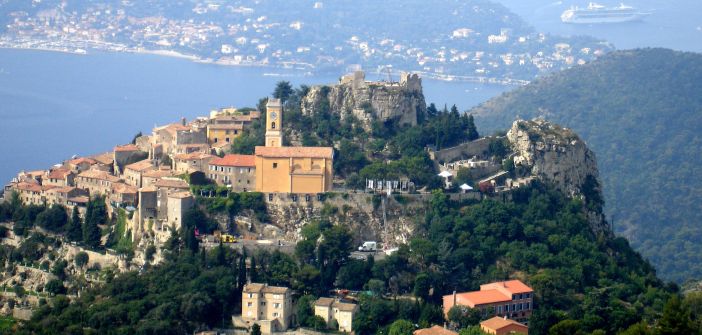No, we will not linger at the seaside resort of Eze, where the sea nonetheless invites us to stroll and enjoy its iodized caresses.
We will take the Nietzsche trail, where the famous German philosopher wrote a large part of his Zarathustra. This mule track leads us into this village, an eagle’s nest and mainly a vantage point for observing the coastline.
Upon arriving at Eze village, we quickly discover traces of its fortifications. We must pass under a porch to access the old village. Often stair-stepped alleys offer the pleasure of an entirely car-free environment, and these cobblestone paths lead us cheerfully to the top of the village where the panorama allows us to admire the Italian coast with the Capo Nero of Bordighera and beyond the rock of Théoule, Cap Camarat and Saint Tropez.
The transparent light makes the landscape even more sublime. In this exotic garden, we can contemplate the vast array of flora with succulents exploding in thousands of colors on this promontory where the sun reigns supreme. We will take advantage of this delightful place to pause and leaf through the history of Eze.
The Aurelia road passed above the village, coming from La Turbie, continuing towards Forum Julii or Fréjus. It is unnecessary to recall the reasons why the communication routes of imperial Rome avoided the shores, preferring the lands’ interior. Avisio, a name given by Antoninus, becomes Esa, Isia by the mid-11th century, and then Eze in the 13th century. It was then the fief of the Riquier and Blacas families.
In 1351, Pierre Fighiera of Eze rendered vassal homage to Queen Jeanne. In 1414, the Savoyards granted communal autonomy, and Eze became a salt depot. In 1534, Barbarossa allied with Francis I and besieged Eze.
The village was a stronghold of the County of Nice, attacked twice by the troops of Louis XIV, in 1691 and 1706, the stronghold was, like that of Nice, dismantled on the orders of Louis XIV. During the Spanish occupation from 1742 to 1748, Eze was ruined by Infant Philippe. Through the revolution, the empire, the restoration, and the Treaty of Turin in 1860, Eze repeatedly switched from France to the Savoy.
The religious heritage of this village consists of the parish church of Notre Dame de l’Assomption of 18th-century Baroque style, the work of Antoine Spinelli; the chapel of the white penitents from 1306 with its sculpted wooden Christ from 1258, made after a plague epidemic; and the Saint Laurent chapel of Eze, which belonged from the 16th to the 19th century to the Rossetto family.
The Château d’Eza (not to be confused with the ruined 12th-century one) was the residence of the King of Sweden. The Plateau de la Justice was the Montfaucon of the lords of Eze. A short detour by the cemetery will allow us to pay tribute to one of our great actors, Francis Blanche, who rests here, facing the sea.
Thus, we evoke in a few lines the history of Eze, and one can leave this exotic garden created in 1949.
We will not descend again by the Nietzsche trail but will take the bridge spanning an impressive ravine. There, a legend explains its construction. It was thrown overnight by the devil. The price to pay was the soul of the first person to cross the viaduct. The devil was tricked because it was a dog that first used it.
Thierry Jan


